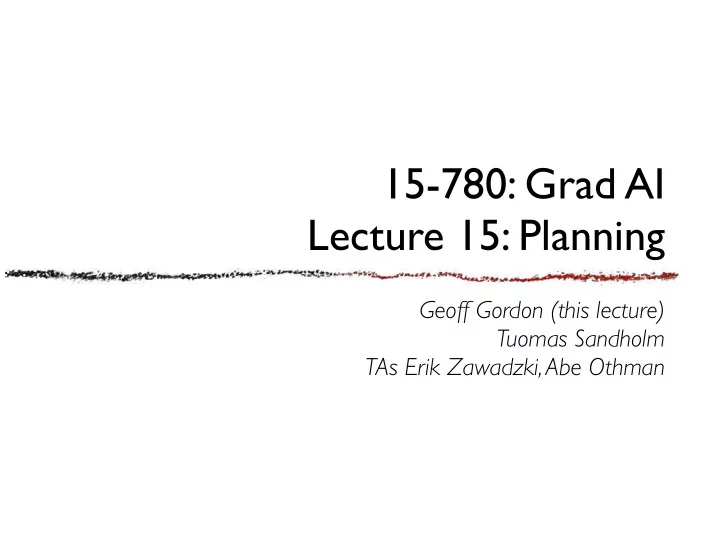

Naive algorithm For i = 1 … points For j = 1 … points included = t For k = 1 … edges if segment ij intersects edge k included = f
Complexity Naive algorithm is O(n 3 ) in planar C-space For faster algorithms, O(n 2 ) or O(k+n log(n)), see [Latombe, p. 157] ‣ k = number of edges that wind up in visibility graph In dimension d, graph gets much bigger, more complex; speedup tricks stop working Once we have graph, search it!
Discussion of visibility graph Good: finds shortest path Bad: complex C-space yields long runtime, even if problem is easy ‣ get my 23-dof manipulator to move 1mm when nearest obstacle is 1m Bad: no margin for error
Getting bigger margins Could just pad obstacles ‣ but how much is enough? might make infeasible… What if we try to stay as far away from obstacles as possible?
Voronoi graph ! $"# $ � $"# � ! � !"# � ! � $"# $ $"# Set of all places equidistant from two or more obstacles: Voronoi graph ‣ point obstacles: network of line segments ‣ nonzero extent: graph may include curves
Voronoi w/ polygonal C-space
Voronoi method for planning Compute Voronoi diagram of C-space Go straight from start to nearest point on diagram Plan within diagram to get near goal (A*) Go straight to goal
Voronoi discussion Good: stays far away from obstacles Bad: assumes polygons Bad: gets kind of hard in higher dimensions (but see Howie Choset’s web page and book)
Voronoi discussion Bad: kind of gun-shy about obstacles
(Approximate) cell decompositions
Planning algorithm Lay down a grid in C-space Delete cells that intersect obstacles Connect neighbors A* If no path, double resolution and try again ‣ never know when we’re done ‣ resolution: want high near obstacles, low everywhere else
Fix: variable resolution Lay down a coarse grid Split cells that intersect obstacle borders ‣ empty cells good ‣ full cells also don’t need splitting Stop at fine resolution Data structure: quadtree
Discussion Works pretty well, except: ‣ Still don’t know when to stop ‣ Won’t find shortest path ‣ Still doesn’t really scale to high-d
Better yet Adaptive decomposition Split only cells that actually make a difference ‣ are on path from start ‣ make a difference to our policy
An adaptive splitter: parti-game G G Goal Start Andrew Moore and Chris Atkeson. The Parti-game Algorithm for Variable Resolution Reinforcement Learning in Multidimensional State-spaces. http://www.autonlab.org/autonweb/14699.html
Parti-game algorithm Sample actions from several points per cell Try to plan a path from start to goal On the way, pretend an opponent gets to choose which outcome happens (out of all that have been observed in this cell) If we can get to goal, we win Otherwise we can split a cell
9dof planar arm Goal Fixed base Start 85 partitions total
Randomness in search
Rapidly-exploring Random Trees Break up C-space into Voronoi regions around random landmarks Invariant: landmarks always form a tree ‣ known path to root Subject to this requirement, placed in a way that tends to split large Voronoi regions ‣ coarse-to-fine search Goal: feasibility not optimality (*)
RRT: required subroutines RANDOM_CONFIG ‣ samples from C-space EXTEND( q , q ’) ‣ local controller, heads toward q ’ from q ‣ stops before hitting obstacle (and perhaps also after bound on time or distance) FIND_NEAREST( q , Q) ‣ searches current tree Q for point near q
Path Planning with RRTs RRT = Rapidly-Exploring Random Tree BUILT_RRT(q init ) { T = q init EXTEND(T, q) { for k = 1 to K { q near = FIND_NEAREST(q, T) q rand = RANDOM_CONFIG() q new = EXTEND(q near , q) EXTEND(T, q rand ); T = T + (q near , q new ) } } } [ Kuffner & LaValle , ICRA’00]
Path Planning with RRTs RRT = Rapidly-Exploring Random Tree q init BUILT_RRT(q init ) { T = q init EXTEND(T, q) { for k = 1 to K { q near = FIND_NEAREST(q, T) q rand = RANDOM_CONFIG() q new = EXTEND(q near , q) EXTEND(T, q rand ); T = T + (q near , q new ) } } } [ Kuffner & LaValle , ICRA’00]
Path Planning with RRTs RRT = Rapidly-Exploring Random Tree q rand q init BUILT_RRT(q init ) { T = q init EXTEND(T, q) { for k = 1 to K { q near = FIND_NEAREST(q, T) q rand = RANDOM_CONFIG() q new = EXTEND(q near , q) EXTEND(T, q rand ); T = T + (q near , q new ) } } } [ Kuffner & LaValle , ICRA’00]
Path Planning with RRTs RRT = Rapidly-Exploring Random Tree q rand q near q init BUILT_RRT(q init ) { T = q init EXTEND(T, q) { for k = 1 to K { q near = FIND_NEAREST(q, T) q rand = RANDOM_CONFIG() q new = EXTEND(q near , q) EXTEND(T, q rand ); T = T + (q near , q new ) } } } [ Kuffner & LaValle , ICRA’00]
Path Planning with RRTs RRT = Rapidly-Exploring Random Tree q new q rand q near q init BUILT_RRT(q init ) { T = q init EXTEND(T, q) { for k = 1 to K { q near = FIND_NEAREST(q, T) q rand = RANDOM_CONFIG() q new = EXTEND(q near , q) EXTEND(T, q rand ); T = T + (q near , q new ) } } } [ Kuffner & LaValle , ICRA’00]
RRT example Planar holonomic robot
RRTs explore coarse to fine Tend to break up large Voronoi regions ‣ higher probability of q rand being in them Limiting distribution of vertices given by RANDOM_CONFIG ‣ as RRT grows, probability that q rand is reachable with local controller (and so immediately becomes a new vertex) approaches 1
RRT example
RRT for a car (3 dof)
Recommend
More recommend